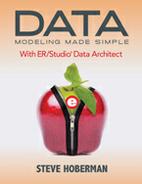Read me first!
Data Modeling Made Simple with Embarcadero ER/Studio Data Architect will provide the business or IT professional with a practical working knowledge of data modeling concepts and best practices, along with how to apply these principles with ER/Studio. You’ll build many ER/Studio data models along the way, applying best practices to master these ten objectives:
1. You will know why a data model is needed and which ER/Studio models are the most appropriate for each situation
2. You will be able to read a data model of any size and complexity with the same confidence as reading a book
3. You will know how to apply all the key features of ER/Studio
4. You will be able to build relational and dimensional conceptual, logical, and physical data models in ER/Studio
5. You will know how to create an efficient physical data model both by forward engineering a logical data model and by reverse engineering a database
6. You will improve data model quality and impact analysis results by leveraging ER/Studio’s compare/merge utility
7. You will achieve enterprise architecture through ER/Studio’s lineage functionality
8. You will be able to apply ER/Studio’s data dictionary features
9. You will learn ways of importing and exporting the data model, as well as how to print and report from ER/Studio
10. You will leverage ER/Studio’s naming functionality to improve naming consistency.
This book contains four sections:
Section I introduces data modeling along with ER/Studio functionality and landscape. Learn why data modeling is so critical to software development and even more importantly, why data modeling is so critical to understanding the business. You will also learn about the ER/Studio environment. Chapter 1 explains the data model and why it is an invaluable wayfinding tool in eliciting requirements and in capturing a precise representation of the business. This chapter also introduces the publisher case study, which we will use throughout the text to explain data model concepts and ER/Studio functionality. Chapter 2 introduces you to ER/Studio Data Architect (ER/Studio). Learn what ER/Studio can do, and how to install and start the software. Chapter 3 covers at a broad level what features are within each ER/Studio tab, window, menu, and toolbar. By the end of this section, you will have created and saved your first data model in ER/Studio and be ready to start modeling in Section II!
Section II explains all of the symbols and text on a data model. Chapter 4 defines a submodel and how to work with submodels. Chapter 5 defines an entity and instances and discusses the different categories of entities. The three different levels at which entities may exist, conceptual, logical, and physical, are also explained. Chapter 6 defines an attribute and key distinguishing the terms candidate, primary, surrogate, foreign, and alternate key. Domains are also introduced in this chapter. Chapter 7 defines rules and relationships. Data rules are distinguished from action rules. Cardinality and labels are explained so that the reader can read any data model as easily as reading a book. Other types of relationships, such as recursive relationships and subtyping are also discussed. By the end of this section you will be able to “read” a data model of any size or complexity, as well as create and modify entities, attributes, and relationships in ER/Studio.
Section III explores the three different levels of models: conceptual, logical, and physical. A conceptual data model (CDM) represents the business need within a defined scope, a logical data model (LDM) the detailed business solution, and the physical data model (PDM) the detailed technical solution. Chapter 8 focuses on the CDM, Chapter 9 the LDM, and Chapter 10 the PDM. By the end of this section you will be able to create conceptual, logical, and physical data models in ER/Studio.
Section IV discusses additional features of ER/Studio. Chapter 11 the data dictionary, Chapter 12 data lineage, Chapter 13 macros, Chapter 14 import, export, printing, and reporting, Chapter 15 naming standards, and Chapter 16 the compare and merge functionality.
To connect the book’s content with the book’s key objectives stated on the previous page: the following table shows the key sections that support each objective.
|
|
Objective | |||||||||
|
Section |
1 |
2 |
3 |
4 |
5 |
6 |
7 |
8 |
9 |
10 |
|
I |
ü |
ü |
ü |
|
|
|
|
|
|
|
|
II |
ü |
ü |
ü |
|
|
|
|
|
|
|
|
III |
ü |
ü |
ü |
ü |
ü |
|
|
|
|
|
|
IV |
|
|
|
|
|
ü |
ü |
ü |
ü |
ü |
Key points are included at the end of each chapter as a way to reinforce concepts. Every chapter starts with a poem in the form of a haiku, which is a three-line poem containing five syllables in the first line, seven in the second, and five in the third. After all, there is a lot of creativity in data modeling!
The book is loaded with hands-on exercises, along with their answers provided in Appendix B. Appendix A contains all of the book’s references, Appendix C a glossary of the terms used throughout the text, and Appendix D a quick reference sheet of ER/Studio commands. There is also a comprehensive index.
